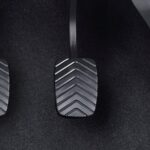Securing your driver’s license is a significant milestone, and the driving test is the final hurdle. As a car expert at cardiagxpert.com, I understand that knowing your vehicle inside and out is crucial for passing your test and, more importantly, for safe driving. This guide will walk you through the essential Parts Of A Car For Driving Test that examiners will be evaluating, both in terms of vehicle functionality and your operational skills. Understanding these components will not only boost your confidence but also ensure you’re well-prepared to demonstrate your driving proficiency.
Pre-Test Vehicle Inspection: Ensuring Your Car is Ready
Before you even start driving, the examiner will check if your vehicle is legally compliant and safe for operation. This pre-test vehicle inspection focuses on several key parts of a car for driving test. Make sure to verify these points before heading to your test center:
- License Plates: Your car must have two license plates, one at the front and one at the rear. These need to be securely attached and clearly visible. Temporary or out-of-state plates are usually acceptable, but ensure they are valid.
Alt text: Close-up of a car’s rear license plate, emphasizing visibility and secure attachment, crucial for pre-driving test vehicle inspection.
- Horn: The horn must be in working order. Test it to ensure it produces a clear and audible sound. A functional horn is a basic safety requirement.
- Turn Signals: Both front and rear turn signals need to be functioning correctly. Check each signal – left and right – to confirm they are blinking clearly and are visible from both front and rear.
- Vehicle Registration: Your vehicle registration must be current and unexpired. Have the registration document readily available in case the examiner asks for it.
- Insurance: Valid and unexpired vehicle insurance is mandatory. Similar to registration, keep your insurance proof handy.
- Rearview Mirrors: At least one rearview mirror is required, either inside or outside the vehicle, or both. Ensure they are clean and properly adjusted for optimal visibility.
- Doors: Both the driver and front passenger doors must open and close normally from both inside and outside. This ensures easy entry and exit in case of emergencies.
- Seatbelts: All seatbelts must be functioning correctly. The examiner will likely check if they buckle and unbuckle smoothly. Always wear your seatbelt during the test and ensure your examiner has theirs on too.
- Brake Lights: Brake lights are crucial for safety. Have someone check that all brake lights illuminate when you press the brake pedal.
- Windshield Wipers: Windshield wipers must be in good working condition. Check that they clear the windshield effectively.
- Headlights and Taillights: Headlights and taillights need to be functional. Test both low and high beams for headlights, and confirm taillights illuminate with headlights and brake lights. Functioning lights are essential, especially if your test is during less than ideal weather or low light conditions.
Alt text: Car headlight and turn signal illuminated, demonstrating working condition for driving test vehicle inspection, emphasizing safety and compliance.
Essential Driving Skills and Car Part Operation During the Test
Beyond the vehicle inspection, the driving test assesses your ability to operate the parts of a car for driving test safely and effectively in real-world driving scenarios. The examiner will observe how you use various controls and how well you apply driving techniques. Here’s what to focus on:
- Steering: Smooth and controlled steering is vital. Avoid jerky movements and sudden turns. Demonstrate your ability to maintain lane position and navigate curves smoothly.
- Acceleration and Braking: Accelerate and brake smoothly and gradually. Avoid sudden acceleration or harsh braking. Show that you can control the vehicle’s speed effectively in different situations.
- Mirrors and Blind Spot Checks: Consistently check your mirrors – rearview and side mirrors – every few seconds. Crucially, always perform shoulder checks (blind spot checks) before changing lanes or merging. This demonstrates awareness of your surroundings.
- Turn Signals: Use your turn signals correctly and in a timely manner. Signal at least 100 feet before turning or changing lanes. Cancel the signal after completing the maneuver. Proper signal usage is a key indicator of safe driving habits.
- Speed Control: Adhere to posted speed limits. Adjust your speed according to weather, road, and traffic conditions. Demonstrate your ability to maintain a safe speed in various situations.
- Following Distance: Maintain a safe following distance. Use the two-second rule in normal conditions and increase it in poor weather or traffic. This shows you understand how to prevent rear-end collisions.
- Intersection Management: Approach intersections cautiously. Know where to stop – before the stop line, crosswalk, or intersection itself. If your view is obstructed, stop, then creep forward slowly, and check for cross-traffic before proceeding. Never roll through stop signs or red lights.
- Lane Usage: Stay in the correct lane. Make turns from the proper lane into the proper lane. This demonstrates lane discipline and awareness of traffic flow.
Alt text: Car side mirror view reflecting traffic, highlighting the importance of regular mirror checks for safe driving and driving test evaluation.
Practice and Preparation are Key
Remember, the driving examiner isn’t trying to trick you. They are there to ensure you can safely operate a vehicle in normal traffic. Practice using all the parts of a car for driving test mentioned above. When practicing, simulate test conditions. Ask your supervising driver to provide feedback, just like an examiner would. Focus on defensive driving, anticipating potential hazards, and demonstrating consistent safe driving habits.
While parallel parking is not always a required part of every driving test, mastering all other aspects mentioned, especially understanding and skillfully using all essential car parts, will significantly increase your chances of passing. Good luck, and drive safely!
